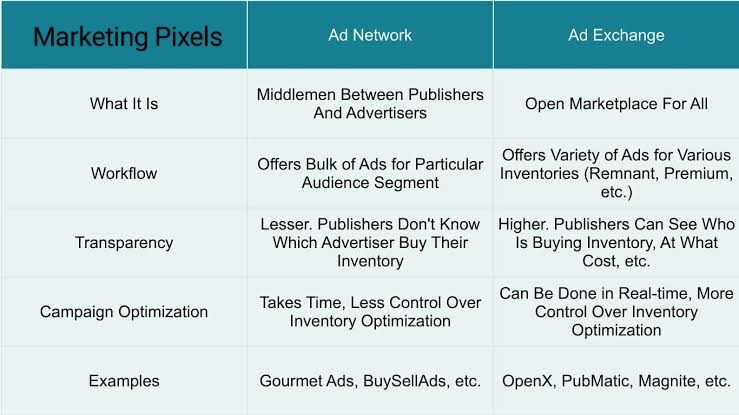Ad Network and Ad Exchange are both important components of the digital advertising ecosystem, but they operate in slightly different ways. Here's a breakdown of the key differences between ad networks and ad exchanges, along with examples:
Ad Network:
An ad network is a platform that acts as an intermediary between advertisers and publishers. It aggregates ad inventory from multiple publishers and offers it to advertisers. Ad networks typically work on a cost-per-click (CPC) or cost-per-impression (CPM) basis and provide various targeting options to advertisers.
Examples of ad networks:
1. Google AdSense: Google AdSense is a widely used ad network that allows website owners to display contextual ads and earn revenue based on clicks or impressions. It offers a wide range of ad formats and targeting options.
2. Media.net: Media.net is a contextual ad network that focuses on delivering relevant ads based on the content of a website. It offers display and native ad formats and serves as a popular alternative to AdSense.
3. Conversant: Conversant is an ad network that specializes in personalized marketing solutions. It leverages data to deliver targeted ads across multiple channels, including display, video, mobile, and social.
Ad Exchange:
An ad exchange is a technology platform that facilitates the buying and selling of digital ad inventory through real-time auctions. It connects multiple ad networks, advertisers, and publishers in a marketplace where ad impressions are bought and sold programmatically.
Examples of ad exchanges:
1. Google Ad Manager: Google Ad Manager (formerly DoubleClick Ad Exchange) is a leading ad exchange that allows publishers to sell their ad inventory to a wide range of advertisers through real-time bidding. It offers advanced targeting options and analytics for better ad optimization.
2. OpenX: OpenX is an independent ad exchange that enables publishers to monetize their inventory and provides advertisers with access to premium ad placements. It offers real-time bidding and private marketplace options.
3. AppNexus (Now part of Xandr): AppNexus is a global ad exchange that facilitates programmatic buying and selling of digital advertising. It offers a range of targeting options and advanced audience data capabilities.
Differences between Ad Network and Ad Exchange:
1. Inventory source: Ad networks aggregate inventory from various publishers and offer it to advertisers, while ad exchanges serve as a marketplace where publishers and advertisers can buy and sell ad impressions in real-time.
2. Control and transparency: Ad networks provide more control to advertisers and publishers over the placements and targeting options. Ad exchanges offer more transparency and control over individual impressions through real-time bidding and programmatic buying.
3. Pricing model: Ad networks often work on a CPC or CPM basis, where advertisers pay for clicks or impressions. Ad exchanges use real-time auctions, where impressions are sold to the highest bidder based on dynamic pricing.
4. Scale and reach: Ad networks generally have a pre-existing network of publishers, offering advertisers access to a wide range of inventory. Ad exchanges typically have a larger pool of inventory and can reach a broader audience by connecting multiple networks and publishers.
In summary, ad networks focus on aggregating inventory and providing targeted ad placements, while ad exchanges facilitate programmatic buying and selling of ad impressions through real-time auctions. Both play important roles in the digital advertising ecosystem and offer different benefits to advertisers and publishers.
Ad networks and ad exchanges are interdependent components of the digital advertising ecosystem. While they serve different purposes, they rely on each other to effectively connect advertisers and publishers and facilitate the buying and selling of ad inventory. Here's how they are dependent on each other:
1. Ad Network as a Source of Inventory: Ad exchanges rely on ad networks to obtain a supply of ad inventory. Ad networks aggregate ad space from multiple publishers and make it available to ad exchanges for auctioning. Without ad networks, ad exchanges would have limited inventory to offer to advertisers.
2. Inventory Quality and Curation: Ad networks play a crucial role in curating and vetting publishers for inventory quality and safety. They establish partnerships with reputable publishers and ensure compliance with advertising guidelines. Ad exchanges benefit from the pre-approved inventory provided by ad networks, which helps maintain a certain level of quality and brand safety for advertisers.
3. Revenue Generation for Publishers: Ad networks provide revenue-generating opportunities for publishers by connecting them with advertisers. Publishers rely on ad networks to monetize their websites or apps by displaying relevant ads. The more advertisers available through ad networks, the greater the revenue potential for publishers.
4. Targeting and Optimization: Ad exchanges rely on the targeting capabilities and optimization data provided by ad networks. Ad networks gather data on user behavior, demographics, and interests to improve targeting efficiency. This data is then utilized by ad exchanges to enable advertisers to reach their desired audience more effectively and optimize campaign performance.
5. Auction and Real-Time Bidding (RTB): Ad exchanges operate on a real-time bidding (RTB) model where advertisers bid on ad impressions in real time. Ad networks facilitate this process by connecting advertisers with the ad exchange's RTB platform. Ad networks provide the necessary infrastructure for advertisers to participate in the auction and bid for impressions on the ad exchange.
6. Revenue Generation for Ad Networks: Ad networks benefit from ad exchanges by expanding their reach and revenue potential. Ad exchanges provide access to a wider range of ad buyers and demand sources, allowing ad networks to sell ad inventory at potentially higher prices. Ad networks can leverage ad exchanges to maximize their revenue and fill any unsold inventory.
In summary, ad networks and ad exchanges rely on each other for the availability and sale of ad inventory, revenue generation for publishers, targeting capabilities, and optimization data. Their collaboration enables the efficient buying and selling of ad space and helps advertisers reach their desired audience effectively.





No comments